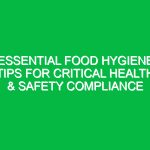Welcome to Today’s Toolbox Talk
Hello team! Today, we’re going to discuss a crucial topic that impacts many of us during the colder months: Winter Weather Driving. As the temperatures drop and snow begins to fall, the roads can turn treacherous. Understanding how to navigate these conditions safely is vital not only for your well-being but also for the Safety of your coworkers and the public. This Toolbox Talk aims to equip you with essential tips and Best Practices for safe driving during winter weather. Let’s dive in!
Understanding Winter Weather Driving
Winter Weather Driving refers to the specific techniques and Precautions needed when operating a vehicle in cold, snowy, or icy conditions. These conditions can significantly affect vehicle performance, visibility, and road traction. In the Health, Safety, and Environment (HSE) context, it’s essential to recognize the Hazards associated with winter driving and how to mitigate them.
The Importance of Winter Weather Driving
Each year, winter storms contribute to thousands of accidents, injuries, and fatalities on the roads. According to the Federal Highway Administration, more than 70% of the US population lives in areas that receive over five inches of snow annually. This statistic underscores the importance of being prepared and informed about Safe Driving Practices during winter months. By focusing on winter weather driving, we can significantly reduce the risk of accidents and ensure a safer working environment for all.
Common Hazards of Winter Weather Driving
Before we go into Best Practices, let’s highlight some common hazards associated with winter weather driving:
- Slippery Roads: Ice and snow can create slick surfaces that reduce tire traction.
- Reduced Visibility: Snowfall, fog, and ice can severely limit how far you can see.
- Cold Weather Effects: Extreme cold can affect vehicle performance, including battery efficiency and tire pressure.
- Increased Stopping Distances: It takes longer to stop on slippery surfaces, increasing the risk of rear-end collisions.
Real-Life Scenario
Imagine you’re on your way to a job site and encounter unexpected snowfall. You may feel tempted to speed up to make up for lost time. However, this can lead to a loss of control and a potential accident. Recognizing these hazards and adjusting your driving behavior is key to winter weather driving.
Best Practices for Winter Weather Driving
Now that we understand the hazards, let’s discuss some best practices to enhance your Safety while driving in winter conditions:
1. Prepare Your Vehicle
Before hitting the road, ensure your vehicle is winter-ready:
- Tires: Use winter tires for improved traction. Check the tire pressure regularly, as it can drop in cold weather.
- Fluids: Ensure your windshield washer fluid is rated for low temperatures and that your antifreeze levels are adequate.
- Battery: Cold weather can drain battery life. Have your battery tested to ensure it’s in good condition.
- Emergency Kit: Carry an emergency kit that includes blankets, snacks, a flashlight, and a first aid kit.
2. Adjust Your Driving Behavior
Once your vehicle is prepared, it’s important to adjust how you drive:
- Slow Down: Reduce your speed and increase your following distance to give yourself more time to react.
- Avoid Sudden Movements: Make gradual adjustments to your steering and braking to prevent skids.
- Use Headlights: Turn on your headlights to increase visibility, even during the day.
- Stay Calm: If you start to skid, steer in the direction you want to go and avoid slamming on the brakes.
3. Know When to Stay Home
Sometimes the best choice is to avoid driving altogether. If a severe winter storm is forecasted, consider postponing non-essential travel. Always communicate with your supervisor if conditions are unsafe for travel to your job site.
Regulations and Company Policies
It’s also important to be aware of any relevant Regulations or company policies related to winter weather driving. For instance, your company may have specific guidelines about travel during severe weather or requirements for reporting unsafe conditions. Ensuring compliance with these policies not only keeps you safe but also protects the organization from potential liabilities.
Understanding Legal Obligations
Remember, if you’re involved in an accident while driving for work, it may have legal implications. Always ensure you’re compliant with local traffic laws and company safety policies to minimize risks.
Open Discussion: Share Your Experiences
Before we conclude, let’s take a moment to share experiences or tips related to winter weather driving. Has anyone encountered a challenging winter driving situation? How did you handle it? This is a great opportunity to learn from one another and discuss practical solutions.
Key Takeaways
To summarize, mastering winter weather driving is essential for ensuring your safety and the safety of others on the road. Here are the key points we covered:
- Understand the common hazards associated with winter driving.
- Prepare your vehicle for winter conditions.
- Adjust your driving behavior to accommodate slippery roads.
- Know when it’s best to avoid driving altogether.
- Be aware of regulations and company policies that govern winter travel.
Conclusion
Thank you all for your attention and participation in today’s Toolbox Talk. Remember, the key to safe winter weather driving lies in preparation, awareness, and communication. By applying the practices we discussed today, we can help ensure that everyone arrives safely at their destination. Stay safe out there, and let’s look out for one another!


